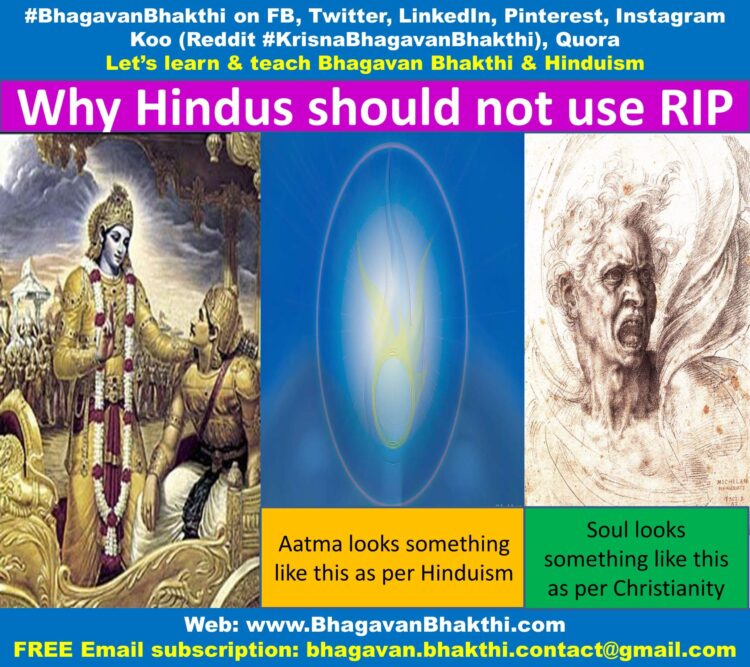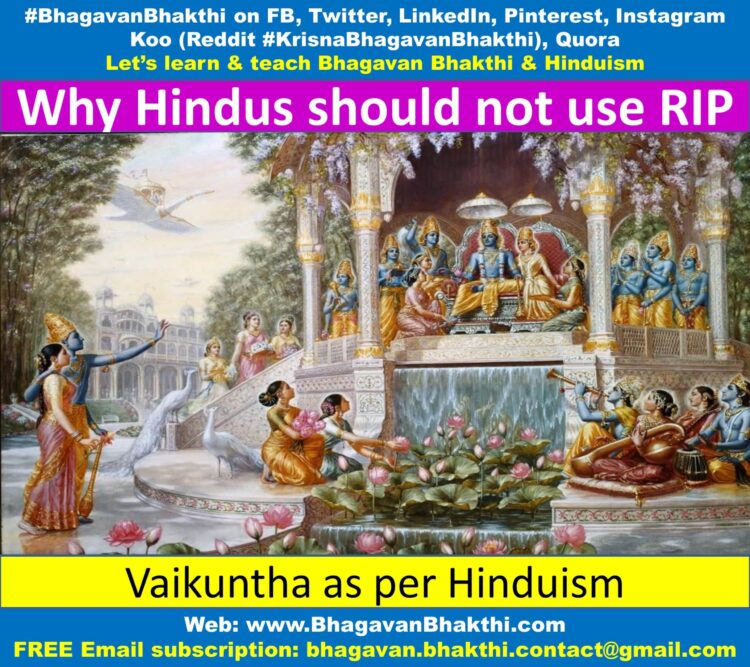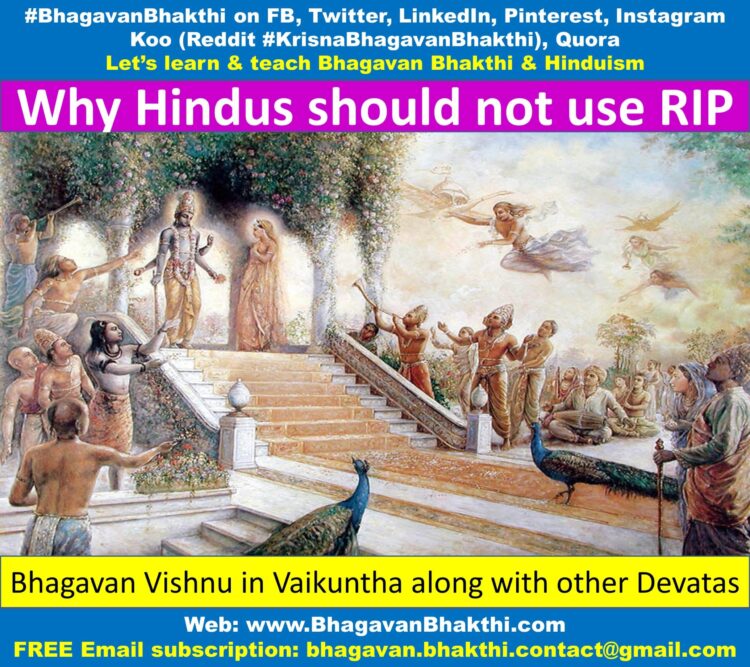Why Hindus Should Not Use RIP (Bhagavad Gita Examples) | Is RIP correct for Hindu? | Why is Om Shanti not RIP? | How do Hindus express condolences? | May his soul attain Sadgati meaning | Om Sadgati message (meaning) | May her (his) soul attain moksha
Namaste friends, how are you doing today? Welcome to #BhagavanBhakthi website / blog.
Bhagavan Lord Sri Vishnu (Krishna, Rama, Trivikrama, Narasimha, Vamana, Vasudeva, Mukunda) and Goddess Lakshmi (Rukmini, Satyabhama, Sita, Kamala, Maya) blessings to you and your family!
In this website / blog, you will always learn about #Hinduism #Sanskrit language.
Also subscribe to my YouTube channel from this link #BhagavanBhakthi to view videos about #Hinduism #Sanskrit language.
Just before going to “Why Hindus Should Not Use RIP (Bhagavad Gita Examples) | Is RIP correct for Hindu? | Why is Om Shanti not RIP? | How do Hindus express condolences? | May his soul attain Sadgati meaning | Om Sadgati message (meaning) | May her (his) soul attain moksha“, let us have a brief some brief information.

First let us know the full form and also let us have a basic idea about RIP. RIP = Rest in peace. This means, if someone dies, he / she is made to rest in peace.
This phrase ‘Rest in peace‘ (RIP) is taken from the Latin, that is, ‘Requiescat in pace‘.
In the Catholic, Anglican, Lutheran and Methodist terminology, to wish the body of a decedent for the eternal rest and peace, Christians traditionally use ‘Rest in Peace’ as services and prayers.
We have to note that Christian use this for the body and they don’t have anything to do with the ‘ātma’ (Divine soul). In Christianity, a soul is described as something like ‘prētātma’ (प्रेतात्म / ಪ್ರೇತಾತ್ಮ ) / ‘Ghost’ / ‘Spirit’ etc. as said in Hinduism.

Whereas in Hinduism an ‘ātma’ (Divine soul) has auspicious meaning. ‘Ātma’ is something which never dies.
In Hinduism only body dies and ‘ātma’ lives until the ‘ananta kalam’ (Grand infinite period / eternity). As said in Hinduism, the ‘ātma’ enters into another body. This is called as reincarnation.
Let us consider a sloka (hymn / verse) from the Bhagavad Gita:
वासांसि जीर्णानि यथा विहाय नवानि गृह्णाति नरोऽपराणि |
तथा शरीराणि विहाय जीर्णा न्यन्यानि संयाति नवानि देही || 2-22||
ವಾಸಾಂಸಿ ಜೀರ್ಣಾನಿ ಯಥಾ ವಿಹಾಯ ನವಾನಿ ಗೃಹ್ಣಾತಿ ನರೋஉಪರಾಣಿ |
ತಥಾ ಶರೀರಾಣಿ ವಿಹಾಯ ಜೀರ್ಣಾನ್ಯನ್ಯಾನಿ ಸಂಯಾತಿ ನವಾನಿ ದೇಹೀ || 2-22 ||
vāsānsi jīrṇāni yathā vihāya navāni gṛihṇāti naro ’parāṇi |
tathā śharīrāṇi vihāya jīrṇānya nyāni sanyāti navāni dehī || 2-22 ||
Meaning of the above sloka: vāsānsi = garments; jīrṇāni = old and worn out; yathā = as it is; vihāya = giving up; navāni = new garments; gṛihṇāti = does accept; naro = a man; ’parāṇi = other;
tathā = in the same way; śharīrāṇi = bodies; vihāya = giving up; jīrṇānya = old and useless; anyāni = different; sanyāti = verily accepts; navāni = new sets; dehī = the embodied.
Translation: As a person gives-up the worn-out garments and wears new garments, similarly, at the time of death, the ‘ātma’ (Divine soul) leaves the worn-out body and enters a new one body.
This very clearly shows that, there is no end to an ‘ātma’ (Divine soul) and only body dies and not the ‘ātma’ (Divine soul) as per the great Bhagavad Gita (Hinduism).

Let us consider another sloka (hymn / verse) from Bhagavad Gita:
शरीरं यदवाप्नोति यच्चाप्युत्क्रामतीश्वर: |
गृहीत्वैतानि संयाति वायुर्गन्धानिवाशयात् || 15-8 ||
ಶರೀರಂ ಯದವಾಪ್ನೋತಿ ಯಚ್ಚಾಪ್ಯುತ್ಕ್ರಾಮತೀಶ್ವರಃ |
ಗೃಹೀತ್ವೈತಾನಿ ಸಂಯಾತಿ ವಾಯುರ್ಗಂಧಾನಿವಾಶಯಾತ್ || 15-8 ||
śharīraṁ yad avāpnoti yach chāpi utkrāmatīśhvaraḥ |
gṛihītvaitāni sanyāti vāyur gandhān ivāśhayāt || 15-8 ||
Meaning of the above sloka: śharīraṁ = body; yad = as much as; avāpnoti = gets; yach = that which; cha = also; api = virtually; utkrāmatī = gives up; isvarah = the lord of the body;
gṛihītva = taking; etāni = all these; sanyāti = goes away; vāyur = air; gandhān = smell; iva = like; aśhayāt—from the flower.
Translation: As the air carries gandha / divine aroma from one place to another place, similarly when ‘ātma’ (Divine soul) leaves an old body and enters a new one the embodied ‘ātma’ (Divine soul) carry the mind and senses with it.
This again very clearly shows that only body dies and ātma further does it’s job, that is, carries the mind and senses.
Another sloka (hymn / verse) from Bhagavad Gita:
अविनाशि तु तद्विद्धि येन सर्वमिदं ततम् ।
विनाशमव्ययस्यास्य न कश्चित्कर्तुमर्हति ॥ 2-17 ॥
ಅವಿನಾಶಿ ತು ತದ್ವಿದ್ಧಿ ಯೇನ ಸರ್ವಮಿದಂ ತತಮ್ |
ವಿನಾಶಮವ್ಯಯಸ್ಯಾಸ್ಯ ನ ಕಶ್ಚಿತ್ಕರ್ತುಮರ್ಹತಿ || 2-17 ||
avināśi tu tadvid’dhi yēna sarvamidaṁ tatam |
vināśam avyayasyāsya na kaścitkartumar’hati || 2-17 ||
Meaning of the above sloka: avināśi = can’t be destroyed; tu = but; tad = that; vid’dhi = know it; yēna = by whom; sarvam = all of the body; idaṁ = this;
tatam = widespread; vināśam = destruction; avyayasya = of the imperishable; asya = of it; na kaścit = no one; kartum = to do; ar’hati = able.
Translation: O Arjuna (Not given in this shloka, but said to Arjuna), you should know that which pervades the entire body can’t be destroyed. No one is able to destroy the everlasting ‘ātma’ (Divine soul).
Again, it is very clear that, ‘ātma’ (Divine soul) is everlasting and can’t be destroyed by anyone.

Another sloka (hymn / verse) from Bhagavad Gita:
देहिनोஉस्मिन्यथा देहे कौमारं यौवनं जरा ।
तथा देहान्तरप्राप्तिर्धीरस्तत्र न मुह्यति ॥ 2-13 ॥
ದೇಹಿನೋஉಸ್ಮಿನ್ಯಥಾ ದೇಹೇ ಕೌಮಾರಂ ಯೌವನಂ ಜರಾ |
ತಥಾ ದೇಹಾಂತರಪ್ರಾಪ್ತಿರ್ಧೀರಸ್ತತ್ರ ನ ಮುಹ್ಯತಿ || 2-13 ||
dēhinōusmin’yathā dēhē kaumāraṁ yauvanaṁ jarā |
tathā dēhāntara prāptirdhīrastatra na muhyati || 2-13 ||
Meaning of the above sloka: dēhinōu = of the embodied; asmin = in this; yathā = as; dēhē = in the body; kaumāraṁ = adolescence; yauvanaṁ = youth; jarā = old age; tathā = similarly;
dēhāntara = transference of the body; prāpti = achievement; dhīrah = the sober; tatra = thereupon; na = never; muhyati = deluded.
Translation: As the embodied ‘ātma’ (Divine soul) continually passes in this body, from adolescence to youth to old age, the ‘ātma’ (Divine soul) similarly passes into another body at death. The self-realized ‘ātma’ is not baffled by such a change.
Another sloka (hymn / verse) from Bhagavad Gita:
अन्तवन्त इमे देहा नित्यस्योक्ताः शरीरिणः ।
अनाशिनोஉप्रमेयस्य तस्माद्युध्यस्व भारत ॥ 2-18 ॥
ಅಂತವಂತ ಇಮೇ ದೇಹಾ ನಿತ್ಯಸ್ಯೋಕ್ತಾಃ ಶರೀರಿಣಃ |
ಅನಾಶಿನೋஉಪ್ರಮೇಯಸ್ಯ ತಸ್ಮಾದ್ಯುಧ್ಯಸ್ವ ಭಾರತ || 2-18 ||
antavanta imē dēhā nityasyōktāḥ śarīriṇaḥ |
anāśinōupramēyasya tasmād yudhyasva bhārata || 2-18 ||
Meaning of the above sloka: antavanta = perishable; imē = all these; dēhā = material bodies; nityasya = eternal in existence; uktah = it is so said; śarīriṇaḥ = the embodied souls;
anāśinah = never to be destroyed; apramēyasya = immeasurable; tasmād = therefore; yudhyasva = fight; bhārata = O descendant of great Bharata.
Translation: Only the material body of the indestructible, incalculable and eternal living entity is subject to destruction; therefore, O descendant of great Bharata, fight now.
This again very clearly shows that, only body is destroyed and not the ‘ātma’.

Another sloka (hymn / verse) from Bhagavad Gita:
न जायते म्रियते वा कदाचिन्नायं भूत्वा भविता वा न भूयः ।
अजो नित्यः शाश्वतोஉयं पुराणो न हन्यते हन्यमाने शरीरे ॥ 2-20 ॥
ನ ಜಾಯತೇ ಮ್ರಿಯತೇ ವಾ ಕದಾಚಿನ್ನಾಯಂ ಭೂತ್ವಾ ಭವಿತಾ ವಾ ನ ಭೂಯಃ |
ಅಜೋ ನಿತ್ಯಃ ಶಾಶ್ವತೋஉಯಂ ಪುರಾಣೋ ನ ಹನ್ಯತೇ ಹನ್ಯಮಾನೇ ಶರೀರೇ || 2-20 ||
na jāyatē mriyatē vā kadācinnāyaṁ bhūtvā bhavitā vā na bhūyaḥ |
ajō nityaḥ śāśvatōuyaṁ purāṇō na han’yatē han’yamānē śarīrē || 2-20 ||
Meaning of the above sloka: na = never; jāyatē = takes birth; mriyatē = never dies; vā = either; kadācit = at any time (past, present or future);
na = never; ayam = this; bhūtvā = came into being; bhavitā = will come to be; vā = or; na = not; bhūyaḥ = or has come to be; ajō = unborn;
nityah = eternal; śāśvatah—permanent; ayaṁ = this; purāṇō = the oldest; na = never; han’yatē = is killed; han’yamānē = being killed; śarīrē = by the body.
Translation: For the ‘ātma’, there is neither birth nor death. Similarly, nor having once been, does he ever cease to be. He (His ātma) is unborn, eternal, ever-existing, undying and primeval. He is not slain when the body is slain.
Another sloka (hymn / verse) from Bhagavad Gita:
वेदाविनाशिनं नित्यं य एनमजमव्ययम् ।
अथं स पुरुषः पार्थ कं घातयति हन्ति कम् ॥ 2-21॥
ವೇದಾವಿನಾಶಿನಂ ನಿತ್ಯಂ ಯ ಏನಮಜಮವ್ಯಯಮ್ |
ಅಥಂ ಸ ಪುರುಷಃ ಪಾರ್ಥ ಕಂ ಘಾತಯತಿ ಹಂತಿ ಕಮ್ || 2-21||
vēdāvināśinaṁ nityaṁ ya ēnam ajam avyayam |
athaṁ sa puruṣaḥ pārtha kaṁ ghātayati hanti kam || 2-21||
Meaning of the above sloka: vēda = in knowledge; vināśinaṁ = indestructible; nityaṁ = always; ya = one who; ēnam = this (soul); ajam = unborn; avyayam = immutable; athaṁ = how; sa = he; puruṣaḥ = person;
pārtha = O Partha (Son of Pritha / Kunti, that is, Arjuna); kaṁ = whom; ghātayati = hurts; hanti = kills; kam = whom.
Translation: O Partha (Son of Pritha / Kunti, that is, Arjuna), how can a person who knows that the ātma is indestructible, unborn, eternal and immutable, kill anyone or cause anyone to kill?

Another sloka (hymn / verse) from Bhagavad Gita:
नैनं छिन्दन्ति शस्त्राणि नैनं दहति पावकः ।
न चैनं क्लेदयन्त्यापो न शोषयति मारुतः ॥ 2-23 ॥
ನೈನಂ ಛಿಂದಂತಿ ಶಸ್ತ್ರಾಣಿ ನೈನಂ ದಹತಿ ಪಾವಕಃ |
ನ ಚೈನಂ ಕ್ಲೇದಯಂತ್ಯಾಪೋ ನ ಶೋಷಯತಿ ಮಾರುತಃ || 2-23 ||
nainaṁ chindanti śastrāṇi nainaṁ dahati pāvakaḥ |
na cainaṁ klēdayantyāpō na śōṣayati mārutaḥ || 2-23 ||
Meaning of the above sloka: nainaṁ = never unto this ātma; chindanti = can cut into pieces; śastrāṇi = all weapons; nainaṁ = never unto this ātma; dahati= burns; pāvakaḥ = fire;
na = never; cainaṁ = also unto this ātma; klēdayanti = moistens; āpō = water; na = never; śōṣayati = dries; mārutaḥ = wind.
Translation: An ātma can never be cut into pieces by any weapon, nor can he be burned by fire, nor moistened by water, nor withered by the wind.
Another sloka (hymn / verse) from Bhagavad Gita:
अच्छेद्योஉयमदाह्योஉयमक्लेद्योஉशोष्य एव च ।
नित्यः सर्वगतः स्थाणुरचलोஉयं सनातनः ॥ 2-24 ॥
ಅಚ್ಛೇದ್ಯೋஉಯಮದಾಹ್ಯೋஉಯಮಕ್ಲೇದ್ಯೋஉಶೋಷ್ಯ ಏವ ಚ |
ನಿತ್ಯಃ ಸರ್ವಗತಃ ಸ್ಥಾಣುರಚಲೋஉಯಂ ಸನಾತನಃ || 2-24 ||
acchēdyōuyamadāhyōuyamaklēdyōuśōṣya ēva ca |
nityaḥ sarvagataḥ sthāṇuracalōuyaṁ sanātanaḥ || 2-24 ||
Meaning of the above sloka: acchēdyah = unbreakable; ayam= this ātma; adāhyah = cannot be burned; ayam = this ātma; aklēdyah = insoluble; aśōṣyah = cannot be dried; ēva = certainly; ca = and; nityah = everlasting;
sarvagataḥ = all-pervading; sthānuh = unchangeable; acalah = immovable; ayam = this soul; sanātanah = eternally the same.
Translation: This individual ātma is unbreakable and insoluble, and can be neither be burned nor be dried. He (One’s ātma) is everlasting, all-pervading, unchangeable, immovable and at the the same time eternal.
Another sloka (hymn / verse) from Bhagavad Gita:
अव्यक्तोஉयमचिन्त्योஉयमविकार्योஉयमुच्यते ।
तस्मादेवं विदित्वैनं नानुशोचितुमर्हसि ॥ 2-25 ॥
ಅವ್ಯಕ್ತೋஉಯಮಚಿಂತ್ಯೋஉಯಮವಿಕಾರ್ಯೋஉಯಮುಚ್ಯತೇ |
ತಸ್ಮಾದೇವಂ ವಿದಿತ್ವೈನಂ ನಾನುಶೋಚಿತುಮರ್ಹಸಿ || 2-25 ||
avyaktōuyamacintyōuyam avikāryōuyam ucyatē |
tasmād ēvaṁ viditvainaṁ nānuśōcitum ar’hasi || 2-25 ||
Meaning of the above sloka: avyaktah = invisible; ayam = this ātma; acintyah = inconceivable; ayam = this ātma; avikāryah = unchangeable; ayam = this ātma; ucyatē = is said; tasmād = therefore;
evam = like this; viditvainaṁ = knowing it well + this ātma; na = do not; anuśōcitum—may lament over; ar’hasi = you deserve.
Translation: It is said that the ātma is invisible, inconceivable, immutable, and unchangeable. Knowing this, you (Arjuna) should not grieve for the body.
Another sloka (hymn / verse) from Bhagavad Gita:
अथ चैनं नित्यजातं नित्यं वा मन्यसे मृतम् ।
तथापि त्वं महाबाहो नैवं शोचितुमर्हसि ॥ 2-26 ॥
ಅಥ ಚೈನಂ ನಿತ್ಯಜಾತಂ ನಿತ್ಯಂ ವಾ ಮನ್ಯಸೇ ಮೃತಮ್ |
ತಥಾಪಿ ತ್ವಂ ಮಹಾಬಾಹೋ ನೈವಂ ಶೋಚಿತುಮರ್ಹಸಿ || 2-26 ||
atha cainaṁ nityajātaṁ nityaṁ vā man’yasē mr̥tam |
tathāpi tvaṁ mahābāhō naivaṁ śōcitum ar’hasi || 2-26 ||
Meaning of the above sloka: atha = if, however; cainaṁ = also this soul; nityajātaṁ = always born; nityaṁ = forever; vā = either; man’yasē = so think; mr̥tam = dead;
tathāpi = still; tvaṁ = you; mahābāhō = O mighty-armed one (Arjuna); naivaṁ = never about the ātma; śōcitum = to lament; ar’hasi = deserve.
Translation: If and however, you think that the ātma is perpetually born and always dies, still you have no reason to lament, O mighty armed (Arjuna).
Another sloka (hymn / verse) from Bhagavad Gita:
जातस्य हि ध्रुवो मृत्युर्ध्रुवं जन्म मृतस्य च ।
तस्मादपरिहार्येஉर्थे न त्वं शोचितुमर्हसि ॥ 2-27 ॥
ಜಾತಸ್ಯ ಹಿ ಧ್ರುವೋ ಮೃತ್ಯುರ್ಧ್ರುವಂ ಜನ್ಮ ಮೃತಸ್ಯ ಚ |
ತಸ್ಮಾದಪರಿಹಾರ್ಯೇஉರ್ಥೇ ನ ತ್ವಂ ಶೋಚಿತುಮರ್ಹಸಿ || 2-27 ||
jātasya hi dhruvō mr̥tyurdhruvaṁ janma mr̥tasya ca |
tasmād aparihāryēurthē na tvaṁ śōcitum ar’hasi || 2-27 ||
Meaning of the above sloka: jātasya = one who has taken his birth; hi—certainly; dhruvō = a fact; mrtyuh = death; dhruvaṁ = it is also a fact; janma—birth; mr̥tasya = of the dead; ca = also;
tasmād = therefore; aparihārye = for that which is unavoidable; arthe = in the matter of; na = do not; tvaṁ = you; śōcitum = to lament; ar’hasi = deserve.
Translation: For the one who has taken his birth, death is definite; and for one who is dead, birth is also definite. Thus, in the unavoidable discharge of your duty, you (Arjuna) should not lament.
Another sloka (hymn / verse) from Bhagavad Gita:
आश्चर्यवत्पश्यति कश्चिदेनमाश्चर्यवद्वदति तथैव चान्यः ।
आश्चर्यवच्चैनमन्यः शृणोति श्रुत्वाप्येनं वेद न चैव कश्चित् ॥ 2-29 ॥
ಆಶ್ಚರ್ಯವತ್ಪಶ್ಯತಿ ಕಶ್ಚಿದೇನಮಾಶ್ಚರ್ಯವದ್ವದತಿ ತಥೈವ ಚಾನ್ಯಃ |
ಆಶ್ಚರ್ಯವಚ್ಚೈನಮನ್ಯಃ ಶೃಣೋತಿ ಶ್ರುತ್ವಾಪ್ಯೇನಂ ವೇದ ನ ಚೈವ ಕಶ್ಚಿತ್ || 2-29 ||
āścaryavat paśyati kaścid ēnamāścaryavad vadati tathaiva cān’yaḥ |
āścaryavaccainam an’yaḥ śr̥ṇōti śrutvāpyēnaṁ vēda na caiva kaścit || 2-29 ||
Meaning of the above sloka: āścaryavat = amazing; paśyati = see; kaścid = some; enam = this ātma; aścaryavat = amazing; vadati = speak; tatha = there;
eva = certainly; ca = also; anyah = others; āścaryavat = similarly amazing; ca = also; enam = this ātma; an’yaḥ = others; śr̥ṇōti = hear;
śrutva = having heard; api = even; enam = this ātma; vēda = do know; na = never; ca = and; eva = certainly; kaścit = anyone.
Translation: Some look on the ātma as amazing, some describe him as amazing, and some hear of him as amazing, while others, even after hearing about him, cannot understand him at all.
Another sloka (hymn / verse) from Bhagavad Gita:
इन्द्रियाणि पराण्याहुरिन्द्रियेभ्यः परं मनः ।
मनसस्तु परा बुद्धिर्यो बुद्धेः परतस्तु सः ॥ 3-42 ॥
ಇಂದ್ರಿಯಾಣಿ ಪರಾಣ್ಯಾಹುರಿಂದ್ರಿಯೇಭ್ಯಃ ಪರಂ ಮನಃ |
ಮನಸಸ್ತು ಪರಾ ಬುದ್ಧಿರ್ಯೋ ಬುದ್ಧೇಃ ಪರತಸ್ತು ಸಃ || 3-42 ||
indriyāṇi parāṇyāhurindriyēbhyaḥ paraṁ manaḥ |
manasastu parā bud’dhiryō bud’dhēḥ paratastu saḥ || 3-42 ||
Meaning of the above sloka: indriyani—senses; parani—superior; ahuh—is said; indriyebhyah—more than the senses; param—superior; manah—the mind;
manasah—more than the mind; tu—also; para—superior; buddhih—intelligence; yah—one which; buddheh—more than the intelligence; paratah—superior; tu—but; sah—he.
Translation: The working senses are superior to dull matter; mind is higher than the senses; intelligence is still higher than the mind; and he (the ātma) is even higher than the intelligence.
With the above explanations, it is very clear that in Hinduism we give very high importance to ātma.
Now, let us go back to RIP:
RIP is the incorrect form of condolence message as per the Hinduism is concerned. RIP means ‘Rest in peace‘ in Christianity. As per Christianity, this short form signifies wishing rest and peace to someone who has passed away.
As per Christianity, they bury the dead body and as per Romans beliefs are concerned the soul rests in peace in the grave until the ‘Great Tribulation Day’ (Judgment Day) arrives.
On the ‘Great Tribulation Day’ (Judgment day), as per Christianity their Lord will decide who goes where, that is, either to Heaven or to Hell. Christians believe that on the ‘Great Tribulation Day’ (Judgment Day) the dead will rise again.
Thus, up-to that time, the soul has to remain inside that coffin. Thus, Christians give the blessings as ‘Rest in peace’ (until the Great Tribulation Day / Judgement Day).
Whereas as per Hinduism (Sanatana Dharma) is concerned, we don’t not have any such kind of theory like the dead will rise again. We the Sanatana Dharmis believe in reincarnation (A new life after the death).
In Hinduism it is said that the cycle of birth and death are governed as per ones Karmas. The deceased individual may or may not take another birth based upon the Karma of his / her life.
(Here may or may not is used as if someone has done the required good Karmas, he / she may get the Moksha / Mukti. If someone gets the Moksha / Mukti, then he / she will not take material birth, instead he / she will live in the Vaikuntha with Lord Sri Vishnu.)
Thus, there is no rest in peace theory in Hinduism and hence, the concept of RIP is not valid in Sanatana Dharma (Hinduism). We Hindus always believe in Moksha (Divine liberation) as per the Hindu Shastras (As given in Hindu divine granthas / texts).
Moksha / Mukti (Divine liberation) from the endless cycles of birth and death can happen if someone has done the required good Karmas.
For this reason, using RIP in Hinduism is completely unacceptable and we should always say, “Om Shanti” or simply “Let the ātma get the required Sadgati (As per his/her earlier Karmas)“.
Here, Sadgati means fate as per our earlier Karmas.
We as Hindus, should and always pray to Lord Sri Vishnu, that may the soul get liberated from the cycle of life and death after the death. Thus we should use the word ‘sagdati’ here.
As said early in this post, the theory of RIP would remotely come close to the concept of ‘prētātma’ (प्रेतात्म / ಪ್ರೇತಾತ್ಮ ) / ‘Ghost’ / ‘Spirit’ etc. This is basically a curse in the Hindu way of life.
This is because, a person becomes ‘prētātma’ (प्रेतात्म / ಪ್ರೇತಾತ್ಮ ) / ‘Ghost’ / ‘Spirit’ etc. only if he / she has committed suicide or has done too many bad Karmas in his / her life.
In Hinduism, if we tell RIP, actually we are praying for the soul to remain locked into a standstill position on Earth as it becomes ‘prētātma’ (प्रेतात्म / ಪ್ರೇತಾತ್ಮ ) / ‘Ghost’ / ‘Spirit’ etc. for eternity.
(Same theory is existing with the Islam also. They use the word ‘Rooh’ (الروح) instead of soul. Both meaning remain the same.)
Dear friends, for this reason in Hinduism there is no such kind of theory of RIP, but instead we have the rituals up-to 13 days after death, so that the ātma gets the required sadgati.
Thus, for 13 days the death’s family members persuade the ātma every day with various invocations and offerings requesting it to leave this earth and move on to it’s next destination. This could be either reincarnation or liberation (Moksha).
By saying ‘Om Shanti’ and / or ‘Om Sadgati’, we evoke the ātma to move on and not remain on earth.
More information will be added to this on regular basis, please visit after some time to know more information.
To know more about Lord Sri Narasimha, please visit this link: Bhagavan Sri Narasimha posts on Bhagavan Bhakthi website
To know more about Lord Sri Vishnu, plase visit this link: Bhagavan Sri Vishnu posts on Bhagavan Bhakthi website
To know more about Lord Sri Krishna, please visit this link: Bhagavan Sri Krishna posts on Bhagavan Bhakthi website
To know more about Lord Sri Rama, please visit this link: Bhagavan Sri Rama posts on Bhagavan Bhakthi website
Dear friends, if you need any clarifications about this post, kindly let me know, I will definitely try to answer all of them.
Also your one LIKE, one COMMENT, One Share, one SUBSCRIPTION is highly important.
This will help to know the quality of this content and also it will be helpful to know if any improvements is required for the content.
If you feel this content is useful to you and has helped you to improve your knowledge, kindly share this with your well-wishers.
Because “SHARING MEANS CARING”.
For receive FREE EMAIL SUBSCRIPTION about #BhagavanBhakthi, you can send an email to bhagavan.bhakthi.contact@gmail.com from your email ID.
NAMASTE!
Sri Gurubhyo Namaha
Sri Venkateshaaya Namaha
Sri Krishnaarpanamastu
Share in Social Media